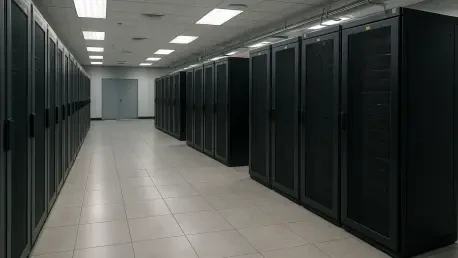In the heart of Silicon Valley, where innovation pulses through every street, a quiet crisis looms over Santa Clara, California—home to Nvidia, the powerhouse behind AI chip technology, and a place that should epitomize progress. Towering data centers, built to fuel the digital age, stand as empty monoliths, unable to power up despite a ravenous global demand for computing capacity. This paradox isn’t just a local quirk; it’s a glaring signal of a deeper fracture in the infrastructure supporting the tech revolution. What halts progress in a place synonymous with cutting-edge advancement? The answer lies in a resource as basic as it is scarce: electricity.
The Heartbeat of Tech Faces a Power Outage
Santa Clara, nestled in the epicenter of technological breakthroughs, should be the last place to falter in supporting the data-hungry world of AI and cloud computing. Yet, facilities designed to process terabytes of information per second remain dormant, their potential locked behind an invisible barrier of insufficient power. This isn’t merely about empty buildings; it’s a stark reflection of a systemic challenge threatening to slow the momentum of an industry that defines modern life.
The significance of this issue extends far beyond local borders. As AI applications expand—driving everything from autonomous vehicles to real-time financial trading—the need for robust data centers grows exponentially. Electricity demands for AI are projected to more than double by 2035, according to BloombergNEF. If a hub like Santa Clara can’t keep up, what does this mean for the broader digital economy? The story unfolding here serves as a critical warning for the entire tech sector, highlighting a bottleneck that could redefine the pace of innovation.
A Surge in Need, a Shortage in Supply
The demand for data centers in Silicon Valley has never been more intense. With tech giants and startups alike pushing the boundaries of artificial intelligence, the appetite for processing power skyrockets daily. Santa Clara, given its proximity to industry leaders like Nvidia, is a prime location for facilities catering to clients who prioritize low-latency connections over cost—think high-frequency traders or developers of self-driving tech. Yet, despite this pressing need, the local grid struggles to deliver the energy required to bring these centers online.
Two major projects spotlight the severity of this shortfall. Digital Realty Trust Inc. applied for power for its SJC37 facility over half a decade ago, aiming to deliver 48 megawatts of capacity, but full energization remains elusive. Similarly, Stack Infrastructure’s SVY02A project, approved several years back, sits idle with plans to lease 12 megawatts unfulfilled. Silicon Valley Power (SVP), the city-owned utility, acknowledges the strain, pointing to a $450 million system overhaul targeted for completion in 2028. Until then, these data giants remain hollow shells, symbolizing a disconnect between ambition and reality.
This power crisis isn’t unique to California. Across the U.S., from Northern Virginia’s “Data Center Alley” to Oregon, similar gridlock hampers progress. Even industry behemoths like Amazon face delays in securing electricity for their operations. The national scope of this problem underscores a troubling trend: while 74.3% of data center construction pipelines are pre-leased, as reported by CBRE, many cannot operate due to energy constraints, leaving billions in investment stranded.
Industry Leaders Sound the Alarm
Frustration echoes through the corridors of tech as leaders grapple with a barrier no amount of funding can immediately solve. Nvidia’s CEO Jensen Huang and OpenAI’s Sam Altman have forecasted trillions of dollars in AI infrastructure investments over the coming years, yet they repeatedly point to power as the critical obstacle. This isn’t a speculative concern; it’s a lived reality for developers staring at vacant facilities in Santa Clara.
Bill Dougherty of CBRE Group Inc. captures the sentiment with blunt clarity: “The constraint isn’t capital; it’s electricity.” Developers share this exasperation, with Digital Realty’s spokesman Jordan Sadler noting wait times in high-demand zones like Santa Clara stretch beyond reasonable limits. In other regions, Dominion Energy Inc. estimates connection delays of one to seven years in Northern Virginia, painting a grim picture for an industry that thrives on speed. These voices collectively highlight a systemic failure, where the backbone of digital progress—reliable power—remains perilously out of reach.
The impact of these delays ripples through the economy. For Santa Clara’s data centers, tailored for clients needing immediate, low-latency access, each day offline translates to lost opportunities for innovation and revenue. Industry insiders warn that without swift resolution, the U.S. risks ceding ground in the global tech race, as other nations prioritize energy infrastructure to support their digital ambitions.
Gridlock on the Grid: Why Power Lags Behind
At the root of Santa Clara’s empty data centers lies a harsh truth: even the most advanced facilities are useless without electricity. The local utility, Silicon Valley Power, faces immense pressure to upgrade an aging grid that wasn’t designed for the explosive growth of data processing needs. While plans for a major overhaul are in motion, the timeline—stretching to 2028—offers little relief for projects languishing today. Interim solutions remain elusive, leaving developers in a frustrating limbo.
This challenge mirrors a broader national struggle. Aging infrastructure, coupled with slow regulatory processes for new transmission lines, creates a bottleneck that stifles growth. In high-demand areas like Santa Clara, the stakes are even higher due to the premium placed on proximity. Unlike sprawling, cost-effective data centers in states like Texas or Louisiana, facilities here cater to niche markets willing to pay for location over scale. The inability to power these strategic hubs disrupts not just local economies but also the specialized services they aim to support.
Compounding the issue are bureaucratic hurdles. Permitting delays and coordination gaps between utilities and policymakers slow the rollout of critical upgrades. For every megawatt left unutilized in Santa Clara, there’s a corresponding delay in deploying cutting-edge technologies that rely on real-time data processing. This gridlock isn’t just a technical problem; it’s a structural one, demanding a reevaluation of how energy delivery keeps pace with digital expansion.
Charting a Path Through the Power Maze
Addressing this crisis requires immediate, multi-faceted action. Utilities like Silicon Valley Power must fast-track upgrades and explore temporary measures to energize stalled projects. While the $450 million overhaul is a step in the right direction, bridging the gap from 2025 to 2028 with stopgap solutions could prevent further economic fallout. Collaboration with developers to prioritize critical facilities might offer a lifeline to those most impacted.
Beyond utility action, tech companies and data center operators should invest in alternative energy options. On-site renewable sources or microgrids could lessen dependence on overwhelmed public grids, providing a buffer against delays. Such innovations, while costly upfront, promise long-term resilience, especially in regions where proximity dictates market value. Pilot programs in other high-demand areas could serve as models for Santa Clara, demonstrating the viability of self-sustained power systems.
Finally, a unified push from policymakers, industry stakeholders, and utilities is essential to streamline regulatory processes. Expediting permits for transmission lines and fostering public-private partnerships can accelerate infrastructure build-outs. For Santa Clara, where location is non-negotiable for certain clients, localized energy strategies must take precedence over blanket national approaches. These combined efforts could transform empty data centers from symbols of stagnation into engines of progress, ensuring that Silicon Valley’s innovative spirit isn’t dimmed by a lack of power.
Reflecting on a Stalled Revolution
Looking back, the saga of Santa Clara’s empty data centers stands as a sobering reminder of the fragility beneath technological triumph. Those vacant structures, looming over Nvidia’s hometown, encapsulate a pivotal moment when ambition outran infrastructure, leaving even the most advanced facilities powerless. The frustration of developers, the warnings of industry titans, and the slow grind of utility upgrades paint a picture of an industry at a crossroads.
Yet, from that struggle emerges a clear mandate for action. Utilities must prioritize rapid grid enhancements, while tech firms explore self-reliant energy solutions to bypass systemic delays. Policymakers, too, bear responsibility to cut through red tape, ensuring that the digital economy’s foundation—electricity—keeps pace with its soaring demands. Moving forward, the lessons learned in Silicon Valley could guide a national effort to align power with progress, turning a cautionary tale into a blueprint for sustaining innovation in an ever-connected world.









